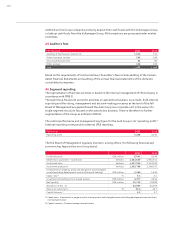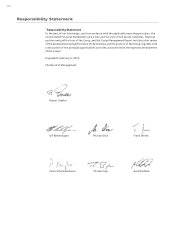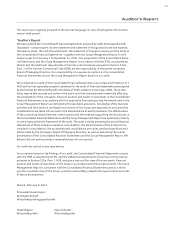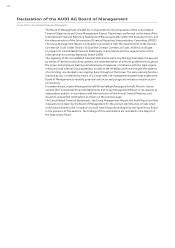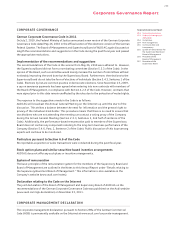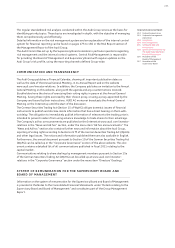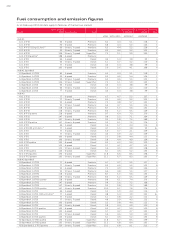Audi 2011 Annual Report Download - page 257
Download and view the complete annual report
Please find page 257 of the 2011 Audi annual report below. You can navigate through the pages in the report by either clicking on the pages listed below, or by using the keyword search tool below to find specific information within the annual report.
254
COMPLIANCE
Responsible and lawful actions are a fundamental aspect of corporate management at the Audi
Group. Compliance as understood in the German Corporate Governance Code means that the
Board of Management must ensure that the statutory provisions and internal company guide-
lines are satisfied, and must endeavor to ensure that the Group companies observe them. The
Audi Group has translated this principle into a preventive, forward-looking understanding of
compliance that globally seeks to ensure that the members of the Company’s corporate bodies
and its employees operate within the rules with regard to the relevant statutory requirements
and prohibitions.
Modeled after the Volkswagen Group, which adopts an integrated approach to compliance and
risk management matters by bracketing them together organizationally and thematically within
the Governance, Risk & Compliance area, the compliance organization was restructured in the
year under review and an area reporting directly to the Board of Management and led by a Chief
Compliance Officer was created within the Audi Group.
The tasks of the Audi Group’s Chief Compliance Officer include in particular advising and sup-
porting the Board of Management, as well as coordinating all necessary measures to assure
compliance. In order to follow through with this approach, Risk Compliance Delegates were
appointed for every division of AUDI AG. In addition, the compliance officers appointed by the
Group companies are the direct points of contact in situ for the Chief Compliance Officer.
Progress on compliance activities was made both nationally and internationally during the period
under review. For example, a Code of Conduct was drawn up for the Audi Group and communicated
throughout the Company. In addition, important aspects of the Code of Conduct were integrated
into corporate processes.
Other priority areas of the compliance program in 2011 involved preventive measures on the
topic of anti-corruption, such as the introduction of web-based training courses. Moreover, the
Board of Management of AUDI AG has declared its unreserved commitment to the compliance
program.
The Audi Group is linked into the Volkswagen Group’s worldwide corruption prevention system.
Independent lawyers acting as ombudsmen and the Volkswagen Group’s Anti-Corruption Officer
both serve as the points of contact on such matters. The latter is available to advise all employees
as well as business partners and third parties on matters relating to corruption such as the admis-
sibility of accepting gifts. All Audi employees may in addition contact the Audi Group’s compliance
organization with queries on any compliance-related topics and for assistance.
The early identification and evaluation of risks is a key aspect of the Audi Group’s approach to com-
pliance. To that end, a Group-wide risk record of relevant compliance topics was compiled in the
period under review.
Activities within the compliance program in 2012 will continue to concentrate on preventive
measures to avoid corruption and on the subject of antitrust law. Here, too, the focus is on training
and informing employees.
RISK MANAGEMENT
Considerable importance is attached to a cautious approach to potential risks within the Audi
Group. The Group-wide risk management system implemented for this purpose helps to identify
and minimize risks, and exclude them altogether if possible. It also provides a basis for respond-
ing swiftly and comprehensively to changing framework conditions.
Central Risk Management operates in partnership with the non-central risk managers in the
divisions and subsidiaries. Central Risk Management sets standards that apply Group-wide and
implements regulations that ensure risks are recorded and evaluated uniformly, as enshrined
for example in an internal Board Directive. Fact-finding events and training courses tailored to
specific target groups were held in order to communicate topics and methods.
In addition, information on risk management was made accessible via internal communication
media such as the intranet.


